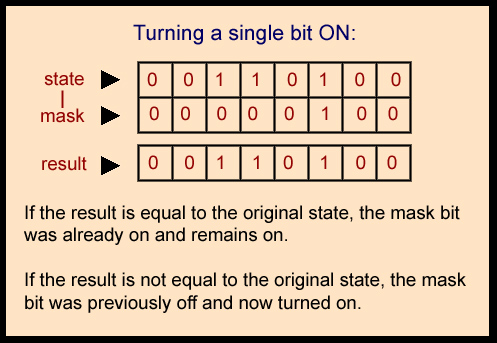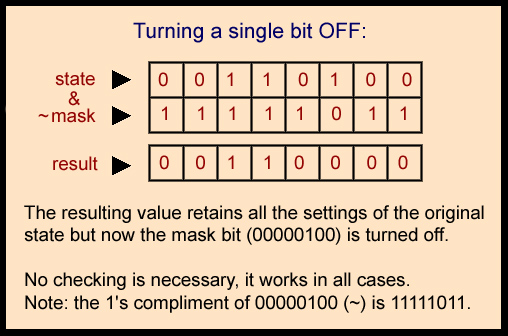BITWISE OPERATIONS
Software bitwise operations are often used to control a virtual
or real machine with a group of settings that can be switched on
or off. The entire group of settings may be represented in a
single unsigned integer type.
The illustrations below use an
8-bit type such as an unsigned char. Using such an 8-bit type would
accommodate a machine whose "states" could range from 0 - 255.
- We might define our settings value like this...
- unsigned char MODE;
-
Each individual setting (or "switch") might be defined in a .h file enumerating the powers
of 2 like this...
-
#define ALL_OFF 0
#define SWITCH_1 1
#define SWITCH_2 2
#define SWITCH_3 4
#define SWITCH_4 8
#define SWITCH_5 16
#define SWITCH_6 32
...etc.
- At startup, we might initialize all of our machine's switches to the off position like this...
- MODE = ALL_OFF;
During the course of the program various switches can be turned on
or off by manipulating the MODE with bitwise operations.
For example, if we wanted to turn switches 1, 3 and 5 ON, we could
use the bitwise OR operator ('|') like this...
- MODE = (MODE | SWITCH_1 | SWITCH_3 | SWITCH_5);
-
If we need to check the current setting of an individual switch say,
switch 3, we could use the bitwise AND operator ('&') like this...
RESULT = MODE & SWITCH_3;
if(RESULT == SWITCH_3)
- printf("Switch 3 is on\n");
- else
- printf("Switch 3 is off\n");
(The illustrations use "state" and "mask" in place of our program's variables MODE and SWITCH_NUMBER. An additional variable RESULT might be used to trap the result of the bitwise operation.)
In the example above, the '&' (AND) operator accumulates powers of 2 in the RESULT variable only where BOTH the MODE AND the SWITCH_NUMBER are ON (both 1's). The bitmask itself (SWITCH_NUMBER) will be filtered down to the RESULT only if that setting was already on. Therefore if the RESULT is equal to the "mask" (SWITCH_NUMBER), that switch is on, otherwise it is off.
To turn a switch ON we can use the bitwise OR ('|') operator as shown in the following illustration...

